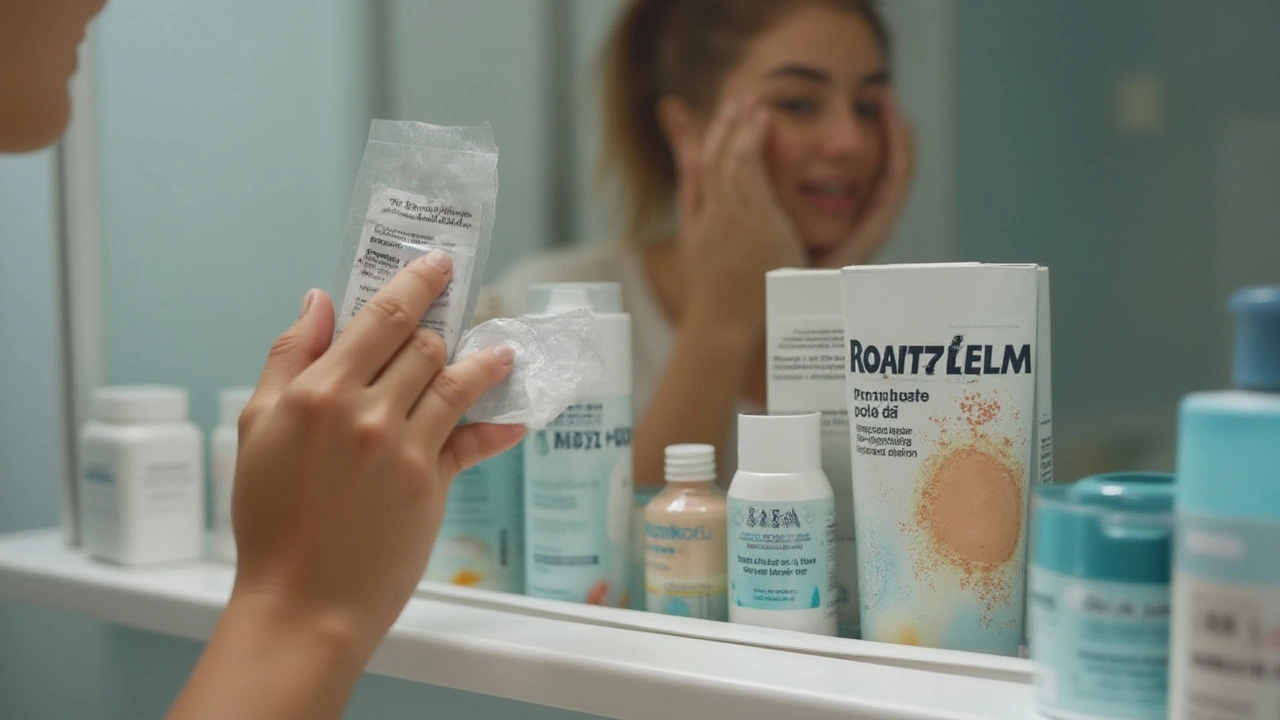The Anacin story starts in a place you might not expect: a 1910s pharmacy, where people were just beginning to demand quick pain relief without a prescription. Today, that little orange bottle sits in millions of American medicine cabinets, trusted for headaches, muscle aches, and those days when just getting out of bed feels like a battle. Yet, most people grab it without a second thought. What exactly makes Anacin work the way it does? Why has it survived waves of newer drugs? And are there hidden risks tucked behind the promise of fast, effective relief? Ready to have your mind changed about what you thought you knew about this trusted pill?
What Is Anacin? The Science and History Behind the Label
Anacin isn’t just a random painkiller. Its roots reach back over a century, when a pair of chemists combined two ingredients: aspirin (acetylsalicylic acid) and caffeine. The combination wasn’t accidental. Aspirin was already known to stunt pain, lower fever, and reduce inflammation. But doctors noticed that the headache-busting effect often felt sluggish. Caffeine, as it turns out, doesn’t just perk you up; it literally speeds up the pain relief process by enabling aspirin to work better and faster. This duo soon carved out a cozy spot among the first over-the-counter painkillers, and advertising claimed Anacin worked “in ways other pain relievers couldn’t.”
The numbers speak for themselves. A 2021 consumer report found that nearly 25% of Americans recognized the Anacin brand—a stat even Tylenol can’t always match. The real magic? The drug’s structure hasn’t changed since the 1940s. It has resisted pharmacy shelf trends, stayed simple, and leaned into old-school strength, all while newer painkillers have come and gone. Some doctors argue that Anacin’s fast action makes it a smart pick for acute pain, like migraines or dental work, when you need quick help. Yet, even with this impressive record, few people could tell you what actually happens after you swallow a pill.
Here’s the play-by-play: the aspirin portion slams the brakes on prostaglandin production—these are chemical messengers that scream “PAIN!” to your brain. Less prostaglandin, less pain. Meanwhile, caffeine is soaking into your bloodstream, blocking another pain chemical called adenosine, which makes your brain churn less pain noise. The effect is synergistic, meaning the two make each other work harder, and that’s why Anacin kicks in—on average—up to 40% faster than standard aspirin alone. For someone who’s aching on a tight schedule, that can mean the difference between losing half a day and powering through the finish line.
Now, a side-by-side might help show where Anacin lands compared to other painkillers.
| Brand | Main Ingredients | Onset Time | Best For | Not For |
|---|---|---|---|---|
| Anacin | Aspirin + Caffeine | ~15 min | Headache, Migraine, Muscle Pain | Kids, GI issues |
| Tylenol | Acetaminophen | ~30 min | Fever, Mild Pain | Liver concerns |
| Advil | Ibuprofen | ~30 min | Inflammation, Joint Pain | Kidney issues |
| Bayer | Aspirin | ~20 min | Fever, Minor Aches | Bleeding risk |
This chart serves as a quick reference the next time you scan your medicine shelf, wondering what to grab for that looming tension headache.
Who Should Consider Anacin—and Who Shouldn’t?
Doctors might reach for Anacin if the goal is to squash pain that feels urgent—think soccer moms with throbbing temples, or students sweating over finals with pounding sinuses. The added caffeine not only supercharges the aspirin; it helps people stay alert, so you’re not fighting off a medicine fog while trying to function. For some, it even doubles as a bonus pre-study or pre-game boost, shaving a few minutes off the caffeine wait time from coffee alone.
Still, this won’t be the golden ticket for everyone. Anacin is strictly off limits for kids and teens with viral illnesses, because aspirin can trigger a rare but deadly condition called Reye’s syndrome—a warning nobody takes lightly. Folks with peptic ulcers, bleeding disorders, or a history of stomach trouble should steer clear, too; aspirin’s anti-inflammatory punch comes with a downside, thinning the blood and irritating stomach linings. As for those allergic to NSAIDs (that’s nonsteroidal anti-inflammatory drugs for the non-pharmacists among us), Anacin can mean trouble. Allergies tend to show up with rashes, swelling, or even asthma-like reactions.
One curious point: caffeine in Anacin can sometimes tip the scales if you’re sensitive to stimulants. If you’re prone to jitteriness, rapid heartbeats, or you struggle with sleep, that extra 32mg of caffeine per tablet might not sound like much, but it can add up—especially if you pop Anacin along with your morning latte.
So how do you know if Anacin is the right fit? Personal medical history matters. You should run this by your doctor or pharmacist if you have:
- History of stomach ulcers or GI bleeding
- Allergies to aspirin or NSAIDs
- Asthma that’s triggered by pain relievers
- Chronic kidney disease
- Liver concerns
- Regular use of blood thinners
- Any condition where you’re told to avoid caffeine
Pregnant or breastfeeding? Skip it—there are safer choices. And watch out for possible interaction with antidepressants, seizure drugs, blood pressure meds, or certain antibiotics. One pharmacist tip: always check drug labels, and don’t double-dip by mixing Anacin with anything else containing aspirin or caffeine.

Smart Use: Dosage, Side Effects, and What to Look For
Proper dosing separates helpful medicine from dangerous mistakes. Adults can generally take 2 tablets of regular Anacin every 4 to 6 hours—never exceeding 8 tablets (which is 2,400mg of aspirin and 256mg of caffeine) in 24 hours. Anything more than that and you’re heading into stomach bleed territory. For people 60 and older, the “less is more” rule matters; metabolism slows, so side effects can crop up with even small missteps.
It’s easy to miss mild side effects, especially since they can mimic what you’re treating: mild stomach pain, queasiness, or even a weird buzzing feeling in your ears. If you notice dark or tarry stools, vomit that looks like coffee grounds, unusual bruising, or bleeding gums, stop Anacin right away and call for help. Those could be red flags for serious bleeding, which isn’t something to tough out at home.
Some less common headaches pop up here, too. Aspirin can trigger an asthma attack in a small group of people—especially those with a history of hayfever or nasal polyps. Caffeine, while helpful for most, can leave some feeling anxious, twitchy, or struggling to sleep. If you get these effects, it’s a sign your body isn’t loving the extra jolt, and it’s smart to switch gears. Hydrate, switch to a plain, non-caffeinated painkiller, and consider reaching out to a health provider.
Another mistake is accidental overdose, usually when people don't realize they're doubling up on medications. Read the packaging closely—products labeled “migraine” relief or “extra strength” usually carry a higher dose of either aspirin or caffeine, sometimes both. When in doubt, less is safer.
If you use Anacin more than twice a week, bring it up with your doctor. Frequent pain could be a clue that something bigger is going on, and constant aspirin can thin the blood over time, upping the risk for bleeding issues you might never see coming. And don’t forget: aspirin and caffeine can stay in your system for up to eight hours, so timing your doses—especially if you’re a light sleeper—can make all the difference.
Real-Life Tips and FAQs for Getting The Most from Anacin
Don’t be fooled by familiar branding or nostalgic packaging—today’s Anacin has the same basic recipe, but people use it differently than they did decades ago. Most of us don’t realize that adding food (even a quick snack) before taking your dose can cut your risk for stomach problems by half. Doctors also suggest sticking to a glass of water, not coffee or orange juice. Acidic drinks boost absorption, but they can hit your stomach hard and make irritation worse.
Another little-known fact? People who’ve never had problems tolerating caffeine can sometimes handle Anacin better in the morning, when the body naturally tolerates stimulants with less anxiety or sleep disruption. If you're treating migraines, there’s a trick: take your dose at the very first sign of pain, not after it’s set in for hours. This targets the inflammation before it builds up, stopping the pain from gaining momentum. Save the higher-dose version for those rare, brutal days, not for daily use.
As for combining Anacin with other remedies, steer clear of mixing with alcohol or other blood thinners unless your doctor explicitly clears it. Not sure if you’re safe to mix Anacin with something else? Some pharmacies now offer on-the-spot checks, just ask if you’re at a big national chain or even a grocery store with a pharmacy counter. It’s fast, free, and can save you a trip to the ER. Always be wary of online "cocktail" advice—what worked for an influencer may not work for you, especially if you have unique sensitivities or take multiple medications.
Here are a few quick answers to questions you might still have:
- Can I take Anacin for a cold or flu? Skip it for young people, especially under age 19—Reye’s syndrome is a real risk. Adults can, but there may be better choices if you’re running a fever or feeling run-down.
- Is Anacin addictive? No, but the caffeine can lead to mild dependence if you’re already sensitive or mixing with lots of coffee.
- What’s the shelf life? About 3 years unopened—after that, aspirin can start to break down. Always check for a vinegar smell; if it’s there, toss the bottle and buy fresh.
- Do generic brands work just as well? If they have the same active ingredients—aspirin and caffeine—they’re essentially the same. Branding adds trust, not extra effect.
- Can I use Anacin for menstrual cramps? Yes, as long as you don’t have heavy periods or bleeding disorders. It can offer solid, fast relief thanks to its potent combination.
Next time you reach for Anacin, remember what’s behind that label—it’s not just a quick fix, it’s science, history, and a touch of caffeine-fueled brilliance. Use it smart, use it safe, and you’ll get the most from one of the world’s original pain relief duos.







Evelyn Shaller-Auslander
July 15, 2025 AT 00:56i just took anacin for my headache and now i feel like a robot who drank 3 espressos lol
Gus Fosarolli
July 15, 2025 AT 03:35anacin: the only painkiller that gives you a buzz and a buzzkill at the same time. caffeine’s the sneaky wingman here, making aspirin look like a superhero. i’d take this over tylenol any day-unless i’m trying to sleep. then it’s just a betrayal.
Leigh Guerra-Paz
July 17, 2025 AT 02:47Wow, I just learned so much about how Anacin actually works-like, I never realized caffeine boosts aspirin’s absorption and blocks adenosine? That’s wild! And the fact that it kicks in 40% faster? That’s not just marketing, that’s science! I’ve been using it for migraines for years, but I never knew why it felt so much sharper than other pills. Also, the warning about mixing it with acidic drinks? I always took mine with orange juice because it tasted better… maybe that’s why my stomach’s been acting up? I’m switching to water now. And the 3-year shelf life tip? I’ve got a bottle from 2021 that smells like vinegar-I’m tossing it right now. Thank you for this deep dive-it’s like a mini pharmacology class I didn’t know I needed.
Jordyn Holland
July 17, 2025 AT 06:27Oh wow, another article glorifying a 1940s chemist’s cocktail like it’s some kind of miracle. How quaint. Meanwhile, people in Europe are using targeted COX-2 inhibitors and still managing to live. Anacin? It’s just aspirin with a caffeine booster-like putting a turbocharger on a bicycle. And don’t even get me started on the ‘trusted’ branding. It’s nostalgia dressed up as efficacy.
Jasper Arboladura
July 19, 2025 AT 01:52Let’s be clear: Anacin’s synergy is well-documented, but the data on caffeine’s adenosine antagonism in migraine pathways is still inconclusive beyond the 15-minute onset claim. Also, Reye’s syndrome is irrelevant for adults, so why is it emphasized? Probably because it’s a scare tactic for marketing. The real issue is NSAID-induced gastropathy, which is underdiscussed.
Joanne Beriña
July 20, 2025 AT 21:03They don’t make painkillers like this anymore-because America’s gone soft. Back in my day, you popped an Anacin, got back to work, and didn’t whine about stomach issues. Now everyone’s scared of a little aspirin and caffeine? We’ve become a nation of hypochondriacs in yoga pants. If you can’t handle 32mg of caffeine, go drink decaf and stop pretending you’re sick.
ABHISHEK NAHARIA
July 22, 2025 AT 11:39Western pharmacology continues to romanticize chemical simplicity while ignoring holistic alternatives. Anacin is a product of industrial capitalism, not medical wisdom. In India, we have turmeric, ashwagandha, and yoga-no caffeine dependency required. This pill is a symptom of our collective inability to sit with discomfort.
Hardik Malhan
July 22, 2025 AT 23:21Aspirin’s COX-1 inhibition + caffeine’s A2A antagonism creates a pharmacodynamic synergy with enhanced CNS penetration. The 15-min onset aligns with Tmax of aspirin when co-administered with caffeine. Caffeine’s half-life is ~5h so dosing intervals should account for accumulation. GI risk is dose-dependent and cumulative over >2x/week use.
Casey Nicole
July 23, 2025 AT 18:20OMG I’ve been taking Anacin for years and I didn’t even know the caffeine was actually helping? Like I thought it was just there to make me feel awake but now I realize it’s a legit painkiller enhancer?? I’m basically a genius for using it all this time. Also, I’ve been drinking coffee with it and I’m not sorry. My brain is a well-oiled machine. If you can’t handle it, don’t use it. #AnacinQueen
Kelsey Worth
July 25, 2025 AT 07:07wait so caffeine makes aspirin work faster? i always thought it was just to keep me from nodding off after taking it. guess i’ve been using it wrong all these years. also i just checked my bottle and it’s expired. i’m gonna toss it and get a new one. who knew aspirin turns into vinegar? weird.
shelly roche
July 25, 2025 AT 13:01Thank you for this thoughtful breakdown! As someone who’s used Anacin for migraines since college, I never knew the science behind it-and now I feel so much more confident using it. The tip about taking it with food? That’s going in my health journal. Also, the fact that generics are just as good? Huge relief. I’ve been paying extra for the brand name thinking it was stronger. Nope. Just branding. And hey, if you’re breastfeeding or pregnant, please listen to the advice. There are safer options out there. You’re not alone in this pain journey. Take care of yourselves, friends. 💛
Emily Nesbit
July 26, 2025 AT 19:35Let’s be honest: Anacin’s 25% brand recognition is a testament to decades of predatory marketing, not clinical superiority. The caffeine content is a deliberate dependency mechanism disguised as efficacy. The article frames this as ‘brilliance’-it’s exploitation. Anyone who uses this regularly without consulting a provider is playing Russian roulette with their GI tract and cardiovascular system. This isn’t science. It’s capitalism.
Richard Elias
July 27, 2025 AT 03:20you people act like anacin is some kind of magic potion. it’s just aspirin. plain and simple. caffeine’s just there to make you feel like it’s working faster. i’ve had migraines for 20 years and i swear by ibuprofen. anacin? nah. i’d rather take something that doesn’t make my heart race like i just ran a marathon.
Mike Rothschild
July 28, 2025 AT 08:31Good breakdown. One thing to add: if you're on blood thinners or have high blood pressure, even the small dose of caffeine in Anacin can be risky. Also, the 8-tablet daily limit? That’s for healthy adults under 60. If you're older, 4 tablets is plenty. Don’t assume you can handle what the label says-your body changes with age. And if you're using it more than twice a week, you’re masking a symptom, not solving a problem. See a doctor.
Ron Prince
July 28, 2025 AT 09:54anacin? more like an-a-cin-ic. america’s favorite painkiller is just aspirin with a caffeine side hustle. why do we still use this? because we’re lazy. we want fast relief without thinking. europe uses better stuff. we still drink soda and pop pills like candy. sad.
Sarah McCabe
July 28, 2025 AT 10:41anacin: the OG pain relief duo 🤝☕️
my grandma used to keep it in the bathroom cabinet next to the toothpaste. i still reach for it when i’m hungover or have a 3am headache. it’s not fancy, but it works. also, the vinegar smell thing? real. i threw out a bottle last year and it smelled like pickles. yikes.
King Splinter
July 29, 2025 AT 02:34Okay, so let me get this straight: we’re praising a drug that hasn’t changed since the 1940s because it’s ‘simple’? That’s not strength-that’s stagnation. Meanwhile, modern pain science has moved on to neuromodulators, targeted anti-inflammatories, and even non-pharmacological protocols like CBT for chronic pain. Anacin is a relic. A nostalgic relic. A relic that comes with a caffeine jolt and a GI bleed risk. We’re glorifying mediocrity because it’s familiar. That’s not innovation. That’s fear of change.